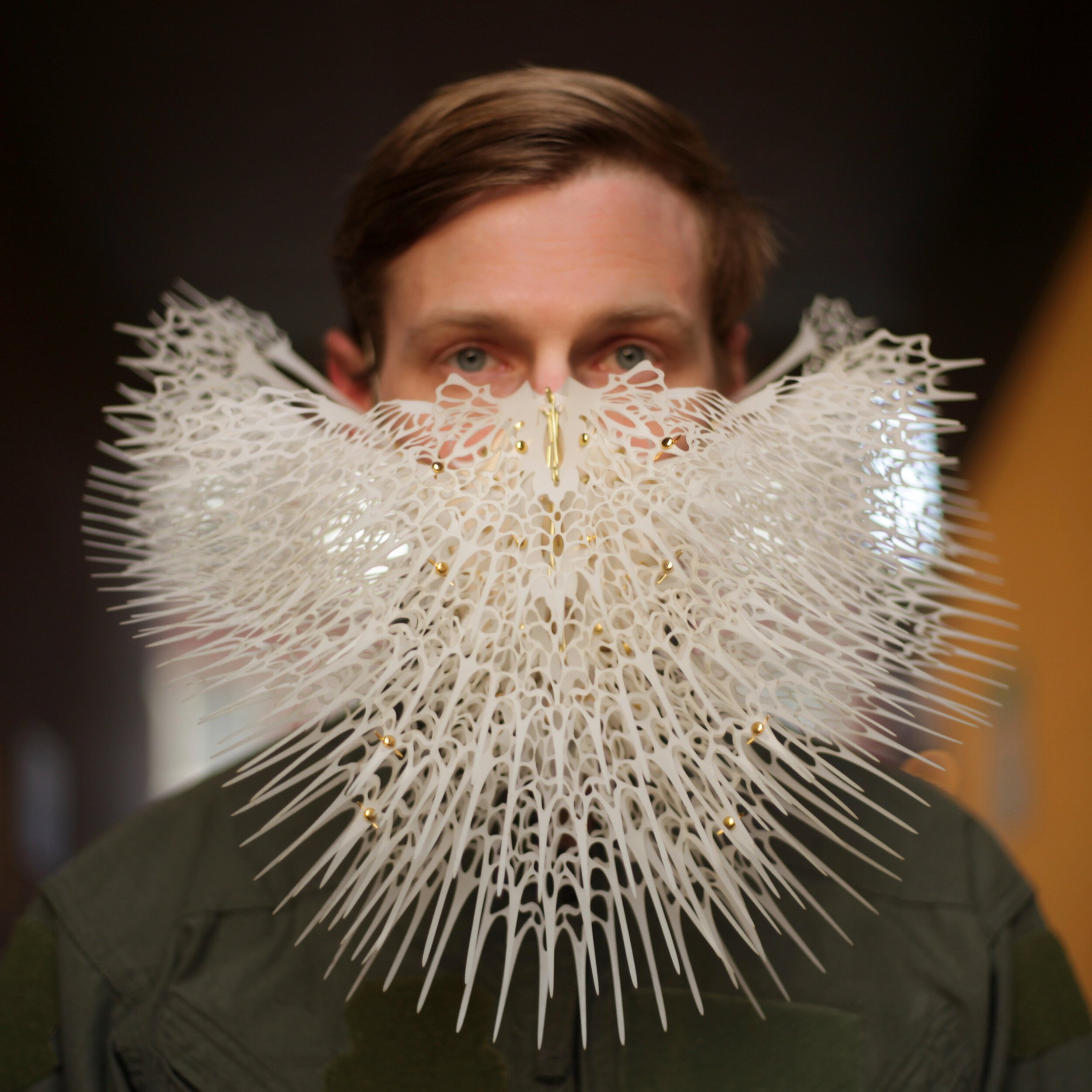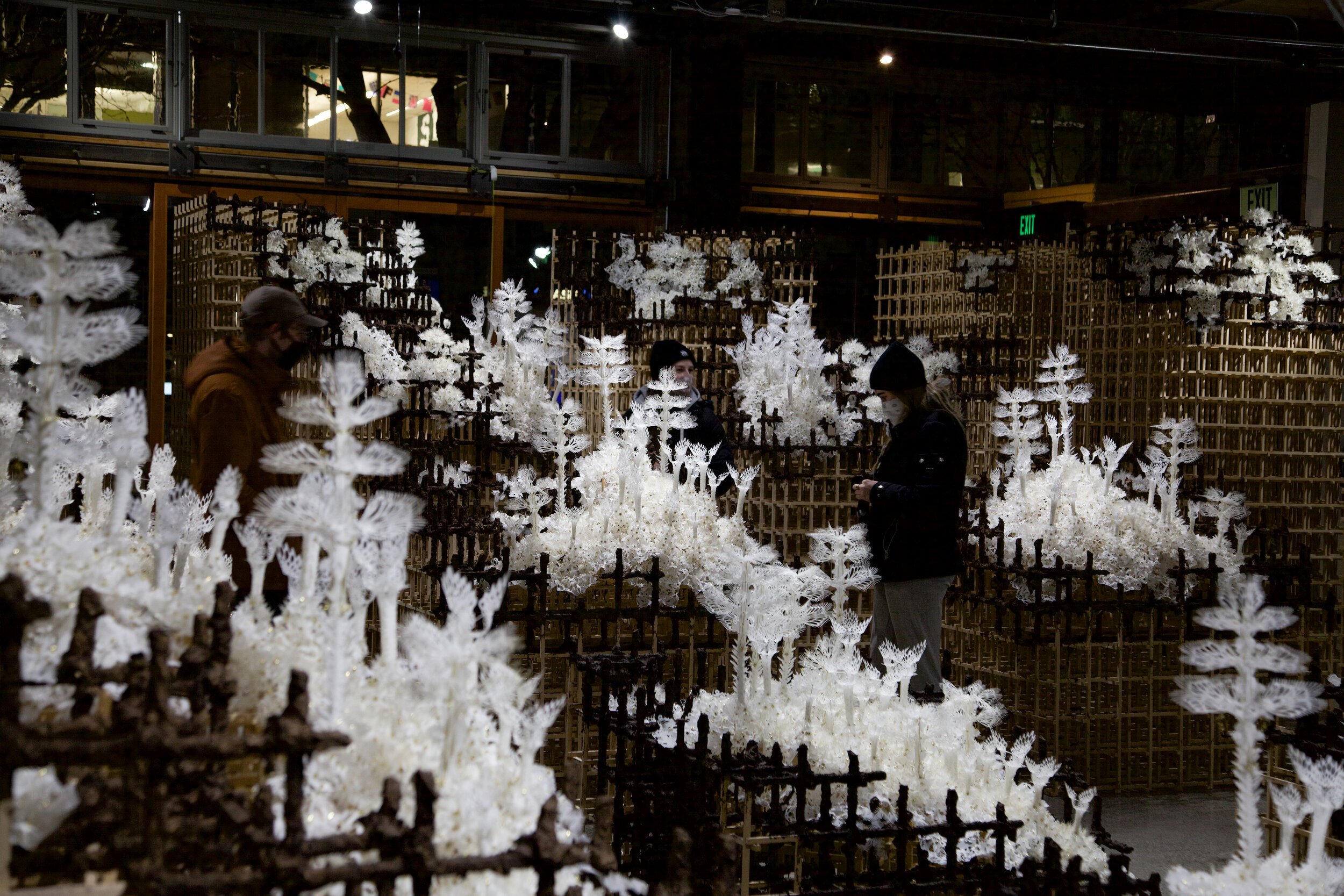Nature, Movement and Mythology: A Conversation with Casey Curran
Being raised in a household of scientists and growing up in a home surrounded by art and science books, my interest in nature-inspired art has followed me ever since I was a child. I met Casey Curran’s work for the first time last summer at Iris Van Herpen’s runway show for Paris Fashion Haute Couture. It was a skeleton sculpture depicting the nymph Daphne —from Ovid’s poem Metamorphoses — placed in the center of the Élysée Montmartre theater. Surrounded by gold laurel leaves suspended from the ceiling, you could appreciate her organza spine waving in the breeze. A delicate yet forceful installation, it made me want to learn more about the artist behind this piece, even before the show started.
A couple of weeks later I reached out to Casey to talk about the language and symbols behind his kinetic sculptures, his relation with natural phenomena, and his beginnings as an artist.
Georgina: You hold a BFA from Cornish College of the Arts in Seattle, from which you graduated in 2006. How do you think your art and your vision as an artist have evolved since then?
Casey Curran: My senior thesis show for Cornish was centered around some pretty esoteric ideas and philosophies. It seems so long ago, but the thrust of the work commented on the “ideas” held in language and symbols. Like Joseph Kosuth’s chair installation, where a physical chair, a photograph of a chair, and the word chair are all stand-ins for one thing/idea. I was combing through philosophy books to find compelling quotes that I could assign mathematical variables to (x, y, z), and with those, I painted simple geometric equations on atmospheric backgrounds. The whole goal was to illustrate an abstract idea as an object through mathematics. The paintings were more or less successful, but my heart was in building kinetic sculptures. As the years progressed, I found myself more focused on movement and how it could become a second element in the concept of my artwork. Almost all of the pieces I’ve completed post-Cornish can be seen as small cyclical environments or landscapes representing elemental phenomena in nature.
Georgina: Nature, art, and architecture are some of the first words that come to mind when I see your work. What other references or ideas inspire you?
Casey: Nature is really the largest influencer on my work, and specifically how the concept of “Nature” fits in with our modern myths surrounding the things we consider natural. I always find myself thinking about the question; are we still a part of nature and if so, what does it mean to live in balance with nature if most of our endeavors have gone toward insulating ourselves from it? I don’t know anyone that would be okay with a bear eating their child or not wanting glasses when you have bad eyesight. I couldn’t imagine not wanting hot water in the winter or air conditioning in the summer. What interests me most are people’s attitudes towards Nature. It’s this push-pull between our animal selves seeking modern comfort and the stories we create to justify that comfort.
Georgina: More than sculptures, when seeing your work we can think of kinetic structures that hold an internal logic. Do you have any previous studies or experience in mechanics or robotics?
Casey: I actually do not have any mechanical or robotic type training. Probably too much of my time and energy has gone into trial and error, but I think coming at the problem of “how do I get this thing to move” from an eye other than a programmer or engineer creates interesting solutions.
Georgina: What role do natural sciences such as anatomy or biology play in your work?
Casey: Pulling microscopic imagery into our macro world is a pretty common element of my work. Whenever I’m looking for inspiration, one of my go-to’s is natural science books. I’m most drawn to Ernst Haeckel’s work. He’s best known for illustrating plankton and other microscopic organisms. When I see his drawings it’s like looking at an alien world, one that happens to exist around us and just out of sight.
Georgina: Can you tell us more about the materials you work with? What role do they play in your art?
Casey: I’m always looking for new materials or production methods to experiment with. I’ve used bird pelts, snake skin, wheat, tar, gold leafing, and plastic doodads to try and get specific ideas across, but wire tends to be my home base when it comes to materials. Laser cutting has also become an increasingly important part of my practice especially as my hands are feeling the wear of decades.
Georgina: What mythological narratives live in your sculptures?
Casey: I love this question. I would say the story of Prometheus or maybe the Oracle of Delphi? I think about all the awful stuff we have coming down the pipeline with climate change. It’s like prophecy with climatologists. They’ve been warning and warning us, but here we are on the cusp of some very hard times. I try and put humanity in a wider perspective when it comes to the next century. There have been at least 5 major extinction events on earth but after each one life persisted. It’s like Prometheus’s liver only to be devoured again and again.
Georgina: The first time I saw one of your sculptures in real life was during Iris Van Herpen’s “Meta Morphosis” runway show for Paris Haute Couture Week last July. Can you tell us more about this experience? How was it to work with Van Herpen and how did you manage to merge your creative process with her vision?
Casey: I’ve worked with Iris on 3 shows now and I was really excited to present the sculpture of “Daphne” for Meta Morphosis. Iris had come to me with greek myths as an underlying theme for her next collection and was specifically interested in the myth of Daphne and Apollo as a sculpture for this show. The idea of how to present Daphne came pretty quickly to me after our Zoom meeting. I felt the figure needed to exist in a position that would express both a succumbing to and lifting away from feeling. There wasn’t much to manage in trying to converge our two aesthetics. Iris has such a long history of alternative materials and techniques when it comes to making her dresses, I knew whatever I brought to the table would fit right in. I also think we pull from similar sources of inspiration.
Georgina: What can you tell us about the current art scene in Seattle?
Casey: I can’t really. I know we have some amazing galleries and artists in this city but mostly my current experience of artwork in Seattle has been entirely curated by Instagram. This is an awful failing on my part, and I probably developed the habit of staying home rather than going out during the pandemic. In my defense, shit is getting wild outside my door.
Georgina: Any upcoming exciting projects that you would like to share with us?
Casey: I do have some exciting projects coming this spring and next winter with a solo show at Heron Arts in San Francisco, an immersive installation at the Museum of Museums in Seattle, and a re-staging of “Daphne” for Iris’s 15-year retrospective at the Museum of Decorative Arts in Paris. 2023 is going to be a busy year for me.



